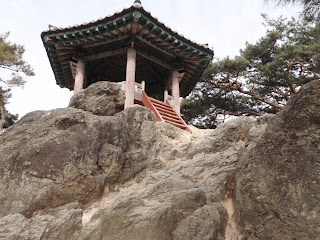So I think I've finally gotten my fill of Baekje culture. I headed up to Gongju (known as Ungjin during the time of the Baekje Kingdom) last month to get a glimpse of the city that served as Baekje's capital from 475 to 538. As a follow up, I traveled to Buyeo (known as Sabi during the Baekje Kingdom) this weekend. The capital was moved from Ungjin to Sabi in 538 and remained there until the fall of the Baekje Kingdom in 660. Both places are pretty small (Gongju has a little over 100,000 people and Buyeo only has about 25,000), but they have nice historical sites and both provide enjoyable day trips for anyone interested in Korean history. If you have to pick between the two, I would say Gongju is probably the better choice, but I had a good time exploring both of them.
I got into Buyeo by catching the 7:45 train out of Waegwan and getting into Daejeon around 9:15. I then headed over to Seobu Bus Terminal and got a bus to Buyeo. I ended up arriving in Buyeo around 11:15 and finally got to my first site, Jeongnimsaji, around noon. Jeongnimsaji is a temple complex from the Baekje Kingdom and is particularly famous for a five-story stone pagoda, which survived the invasion of Sabi and actually details the exploits of the Silla and Tang forces as they conquered the Baekje Kingdom. The site is also home to Jeongnim temple, which houses a stone Buddha statue from the Goryeo period. A museum is also located on the site, but there really isn't too much to see.
 |
| Five-story pagoda and Jeongnimsa |
 |
| Buddha statue located inside Jeongnimsa |
Moving on from Jeongnimsaji, I headed over to the Buyeo National Museum. The museums in Gongju and Buyeo are about the same size, but Gongju had a much more interesting outdoor display. As for the inside, there were three things in Buyeo's museum that really caught my eye. The first is a Baekje incense burner, which is prominently displayed and is obviously the highlight of the museum's collection. I also really enjoyed the rock-carved Buddhist statues and the Avalokitesvara Bodhisattva statue. Overall, the museum is definitely worth the price of admission (it's free) and they were doing lots of construction so it looks like they might be trying to expand the collection.
 |
| Baekje incense burner |
 |
| Buddha statues |
 |
| Avalokitesvara Bodhisattva |
Moving on, I took a stroll to the outskirts of Buyeo to check out the Baekje Royal Tombs. Again, I'm gonna have to compare these with the tombs at Gongju and say that Gongju's tombs were a little better. There really wasn't much to the museum at this site. However, the one advantage over Gongju is that they actually allow you to look inside some of the tombs and one of these tombs has restored paintings on the walls.
 |
| Inside one of the tombs |
I traveled back into town after the viewing the tombs and arrived at Busosanseong, which was my final destination for the day. This is the one place where I would definitely give the advantage to Buyeo. There are numerous pavilions and shrines scattered throughout the fortress and the most famous site is Nakhwaam Rock. Legend says that 3,000 women through themselves off of this rock after the fall of Baekje to avoid being captured by the Silla and Tang forces.
 |
| Artist depiction of the women who jumped off of the rock |
 |
| Nakhwaam Rock |
So that about sums up my day in Buyeo. I'm planning to take off work this coming Friday and travel to Mt. Seorak for the weekend, which should provide some spectacular views. I'm really looking forward to it, so wish me luck on that!








It's alllivvveee! The blog is back alive! Hey everybody, it's music time.
ReplyDelete